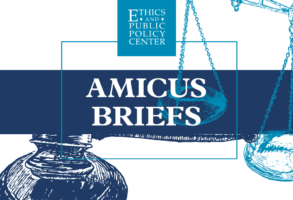
Published June 6, 2024
In mainstream public policy conversations—the ones that happen between a two-by-five grid of talking heads on cable news or over coffee and yogurt parfaits in a D.C. conference room—the sky is perpetually falling for American families.
When the pandemic hit, left-leaning advocacy groups argued that a “she-cession” would lead to millions of women leaving the workplace and that child care costs now routinely exceed $50,000 per year. Politicians love to get in on the act, too. Without its signature Build Back Better legislation, the Biden administration claimed that “half of the population [would be] forced to leave their jobs, cut back on their hours, or unable to access good jobs.” Sens. Elizabeth Warren and Tina Smith warned voters “if the Republicans have their way, more than 3 million babies will lose their child care” due to the pending “child care cliff.” These statistics form the backdrop of books that argue America’s mothers are “screaming on the inside” or barely “holding it together.”
No one denies there are countless ways America could become more family-friendly, including by meaningfully expanding parents’ child care options when their kids are little. The way we work, live, and balance our multiple responsibilities could benefit from a stronger focus on creating systems that work for parents, rather than treating the decision to have a child as something orthogonal to a healthy economy. Many parents feel the strain of having multiple child care payments on a paycheck squeezed by inflation and the ever-rising cost of housing. Our politics can and should do a better job addressing these and related concerns.
Nevertheless, the dominant mainstream narrative of parents made miserable by the country’s lack of investment in a federal child care program doesn’t fit the data. We all know bad news sells; “things could be better, but overall are doing pretty well” rarely drives clicks or garners large grants. But trying to galvanize policy change by hyping the friction and pain points that parents face as apocalyptic threats does parents a disservice. An excessive doom-and-gloom approach to questions of work and family life paints a picture that is dimmer than actual reality, undoubtedly scaring off couples who might be tempted to start a family but afraid to pull the trigger.
Take the gender pay gap. Far from being exacerbated by COVID-19, it now stands at an all-time low, existing not so much between men and women as between moms and everyone else. New research out of Scandinavia suggests that even the extent of the “motherhood penalty” may be overstated. As the socialist policy analyst Matt Bruenig suggested, the apparent earnings penalty may be, at least in part, “because women choose to have kids around the time that their earnings levels are already flattening out.”
The recent parade of horribles also turns out to have been exaggerated for political effect. The “she-cession” was over essentially as soon it started, put to bed by the rise of remote work and the post-COVID tight labor markets that boosted workers’ take-home pay. In the fall of 2023, pandemic-era federal child care supports were scheduled to expire, leading talking heads to warn of the “child care cliff” that would decimate the industry. Nearly a year later, child care operators employ 34,000 more employees than last summer, when the rug was supposedly being pulled out from under them. And while the child care industry will doubtless continue to experience some churn, the tidal wave of closures predicted by the alarmists has not materialized—partly because of state-level action and partly because of favorable macroeconomic conditions.
The source of the most viral statistics about how much parents pay for child care comes from Care.com, an online child care marketplace service where parents search for nannies and babysitters. But those surveys capture only parents who currently pay for professional child care, meaning that those with informal arrangements aren’t included. While some parents will indeed be paying out the ear for nannies or high-end programs, federal data shows that most parents pay less than five figures annually for their child care, particularly those who live outside major metro areas—that is, parents whose experiences aren’t reflected on cable news or in congressional hearings. In federal surveys, three-quarters of parents who use child care report they had a “good choice of programs available” to select from, far from the hellscape the early childhood landscape is often portrayed as.
Long-term trends, too, are better than headlines suggest. When Arizona State University economist Chris Herbst re-analyzed child care spending using the most common amount spent, rather than the mathematical average, he found costs rose only 14 percent over the 1990s and 2000s, not the 40 percent more often cited. Additionally, in 2023, 74 percent of women with children at home were in the labor force—at or near an all-time high. The number of women who wanted to be working, but couldn’t because of their family responsibilities, fell by 20 percent from 2022 to 2023.
And at the macro level, the dire picture of child care affordability—if it were true—might explain why fertility rates in the U.S. have plunged since the Great Recession. But nations with generous social spending on universal child care have birth rates even lower than here. And a 2022 paper in the Journal of Economic Perspectives found that places in the U.S. “where childcare expenditures increased more did not experience a noticeable drop in birth rates.”
On and on it goes. Despite the tumult of the pandemic and its aftermath, the outlook for working parents is far from dystopic. But the tendency to push the more dire interpretation of the data is a recurring problem with domestic policy writ large, particularly on the left. On his Substack Slow Boring, left-leaning contrarian Matt Yglesias has dubbed this tendency “Debbie Downer progressivism.” The progressive tendency to accentuate the negative, he suggests, stems from the belief that “a cosplay version of 19th century revolutionary politics where their theory of change is that they need to rouse people to anger.”
Take climate change. Trendy doomerism ignores the major strides the U.S. has made toward reducing emissions and generating reliable and cheap green energy. Similarly, some on the left have been reluctant to talk up the post-COVID economic recovery, preferring to focus on their call for ever-larger social welfare spending.
Like these two issues, being willing to admit most American parents aren’t facing a crisis is implicitly seen as undermining the case for social-democratic revolution. Therefore, politicians and pundits on the left fall for the worst-case scenario painted by activists.
Republican politicians, meanwhile, avoid the trap of too dour a view by too often opting for general apathy toward policies that could improve financial stability or child care options for families. When The 19th, a news site focused on women’s issues, polled members of Congress on their approach to child care, only five Republicans sent back a response. And some, of course, are inclined to oppose child care on principle. That stance is also a conceptual mistake and a political albatross, particularly in a post-Dobbs environment where more women might be welcoming children they weren’t fully prepared for and needing to provide for them.
One fundamental goal of public policy should be making life easier for all parents, including those who want to stay home with young kids. But many parents want or need to work, at least part-time; headlines about a resurgence in “tradwives” or full-time homemaking are, as the above data shows, premature at best and wish-casting at worst.
Therefore, fixes to child care are needed. Improving child care options for parents should entail a focus on new supply. This should include federal incentives for states to make it easier to open a child care facility by streamlining licensing, relaxing worker education requirements, or reforming zoning. These moves are starting to happen at the local level. The city of Austin, Texas, for example, just rezoned to allow home-based child care within most of the city limits. In Wisconsin, GOP lawmakers have proposed a revolving loan program to allow child care providers to retrofit or renovate their facilities, enabling more centers to scale up. This summer, Montana passed a measure that will exempt in-home daycares from state requirements while expanding their low-income child care assistance program. Recent bipartisan legislation in Michigan newly allows child care providers to operate in multi-use buildings and will provide technical assistance to small, home-based operations.
While this is a promising start, states could still think bigger. This past fall, California passed a “Yes in God’s Backyard” bill granting faith-based communities streamlined permits for new housing. States should try something similar with faith-based child care. Child care regulations can run into the hundreds of pages, up to specifying how many balls and puppets must be provided in each classroom; governors should prioritize pruning back that excessive red tape.
Most importantly, policy efforts should continue to stress the importance of parental choice, recognizing that many families don’t need or want full-time, center-based care. One such example comes from Virginia Gov. Glenn Youngkin, whose multi-faceted child care initiative would include cutting regulatory red tape, new funding partnerships with civil society, workforce development dollars, and more.
This requires a greater humility on the part of policymakers. Relying on faulty narratives to push large-scale solutions many parents don’t necessarily want will make it harder to secure bipartisan support for measures that could improve the early childhood landscape. Rather than implicitly assuming proposals around family life should be constructed around the preferences of either D.C. elites or stay-at-home parents, policy proposals should aim to undergird families across all walks of life.
A sober approach to child care—away from either the Leave It to Beaver memes decrying working moms or breathless catastrophizing about Republicans wanting babies to lose their child care—can improve the landscape. The ceiling may have some cracks, but it isn’t about to cave in on America’s parents. Telling them otherwise is willful misinformation.
Patrick T. Brown is a fellow at the Ethics and Public Policy Center, where his work with the Life and Family Initiative focuses on developing a robust pro-family economic agenda and supporting families as the cornerstone of a healthy and flourishing society.









